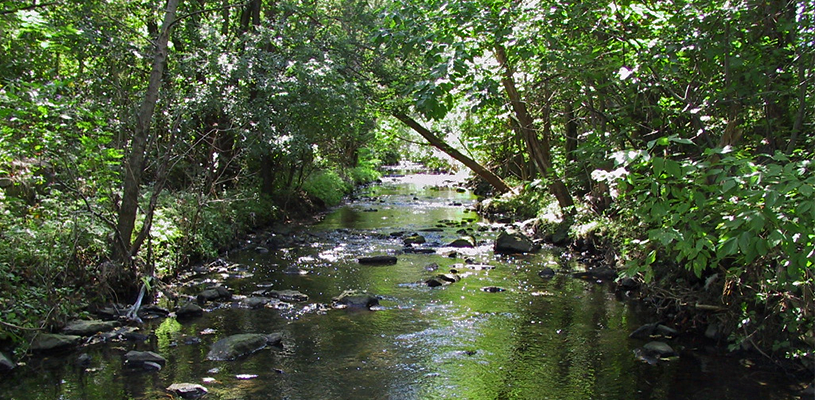Insights from today’s stormwater management approach

Rehabilitation of Ottawa’s Pinecrest Creek will provide a roadmap to future retrofits
The Pinecrest Creek subwatershed – like much of the City of Ottawa’s downtown core – was developed before the more modern requirements for stormwater management. As such, the area has been degraded over decades.
This led the city to take a look at addressing a wide range of deficiencies within the watershed. For one thing, there are hardly any fish in the creek due to the need to improve water quality in the creek and the Ottawa River. Reducing flooding and erosion along the creek was another priority. Improvement of the health of the creek was another problem that needed to be addressed. But also, the city realized the condition of the subwatershed affected Westboro Beach because the creek drains into the Ottawa River. This means everything flowed down past Westboro Beach, often leading to closures.
All these problems needed to be addressed, said Darlene Conway, Sr. Engineering SWM Projects with the City of Ottawa.
“Everybody’s got 20/20 hindsight. We saw this as an opportunity. There’s still a lot that can be done,” she said. “All of the partners involved, whether it’s the NCC (National Capital Commission), the city, the RVCA (Rideau Valley Conservation Authority), there’s a lot that we can do to sort of turn back the clock in terms of trying to bring back the health of that watercourse. And it’s not going to happen overnight. It’s going to take time.”
Retrofit Plan Leads to Pinecrest Rehabilitation
To address this problem, the city came up with the Pinecrest Creek/Westboro Stormwater Management Retrofit Study. Presented in 2011, the plan provided a template for stormwater management retrofits.
The city owns “a lot of stuff in the watershed,” Conway said. It owns all the rights of way. It owns a lot of property as well. The city handles the rehabilitation of the pipes. The city must rebuild area roads when they come to the end of their life cycle. So, the decision was made to focus attention on rehabilitating Pinecrest Creek.
Mind you, as the saying goes, Rome wasn’t built in a day. So, the retrofit study served to provide the city with a long-term roadmap.
One of the city’s major recommendations was to build a stormwater management pond on NCC land. So, the city partnered with the NCC for creation of a pond that will treat about 20 percent of the watershed. That, Conway said, is a huge step forward.
Newer Ways of Stormwater Management
Other things the city will do as it moves through rehabilitation work – roads, etc. – is to try and build in storm water management. An example of that, Conway said, can be found in the city’s Hemmingwood Way traffic management area.
This is where the city is undertaking what Conway describes as “a newer way of doing stormwater management” called low impact development. It is a land planning and engineering design approach to manage stormwater runoff as part of green infrastructure.
And so, the city has built what are called bump-outs, which as the name suggests, pump out the curb so water from the road drains into a planted area. Underneath there’s granular bio media, which collects that water, treats it, and it promotes its sinking back into the ground.
“Can we do this work? You’ve got to do it places where the city can actually implement those things,” Conway said. “So, we’ll be moving forward with more of those. That’s an example of the kind of thing that is being built now.”
Public Support Key for Watershed Future
There are ways the city can support stormwater management. For example, there’s another group at the city that’s working on a program called Rain Ready Ottawa. This initiative involves reaching out to residents directly. This is important because approximately 40 percent of the watershed is made up of residential homes. As such, Conway said, the city doesn’t have the authority to tell people what to do on their own property to reduce runoff.
But, as part of an incentivize program, people can apply for assistance to do things themselves. This will allow their property limit runoff, slow it down, and allow the water to soak back into the ground.
The retrofit in the Pinecrest Creek is one of 16 short-term projects included in the City of Ottawa’s River Action Plan
A lot of the work in the area is a result of that retrofit study. It allows the city to move forward with the goal of reducing the runoff, improving the water quality, and slowing down the flows. This way, the impact will mean less erosion. It will mean less flooding. It also will mean a healthier creek that could one day promote healthier flora and fauna in the area.
Conway admits city staff aren’t sure the fish population will ever return. After all, there’s a big barrier at the Ottawa River, which is a big pipe. But staff do look forward to doing what they can. Someday, that pipe could be daylighted (opened up) and it will become a true creek again all the way to the river.
“That’s fairly far down in the future. Who knows what will happen,” Conway said. “We have to start working. We have to start working on the things that we can work on and move forward with. It’s a long-term plan.”
Environmental Rehabilitation Benefits
Ottawa is not the only city doing this kind of environmental rehabilitation work. Many cities, large and small, grew and expanded before modern approaches to stormwater management. And as such, many of these communities are dealing with the same issues.
This is true in the case of the Pinecrest Creek watershed. It isn’t only about protecting the creek, which is a great resource. But there is also a beach downstream. The work in the watershed will improve that resource. That, in turn, will improve recreation options for the area. The work is protecting infrastructure and reducing flood risks.
These things all contribute to the rationale for doing this kind of work.
“The big message is you’re stronger together. You’ve got to work with all the partners,” Conway said. “You’ve got to work with all the disciplines. You’ve got to arrive at an overall solution that you have to work out with all these people and the public.”
Lessons for Municipal Colleagues
Amanda Lynch is Sr. Project Manager for the City of Ottawa. Like Conway and her colleagues from across the country, Lynch has sat in on many workshops and conferences.
Is it realistic to think people can take away important lessons from the work of other communities? Can municipal staff from across the country take the insight learned in one community and apply them for use in their own? Lynch believes so.
There will always be projects that will resonate more for some people than others, Lynch said. But shared experiences, she said, can provide a valuable tool.
“For folks who maybe thought this is something they should do, but it almost might seem like an impossible undertaking, I think sometimes hearing about other municipalities, hearing about their experiences and successes can be in itself a bit of a motivator,” Lynch said. “Maybe it motivates others to pursue a direction as well, knowing that this can be done. It is not going to be easy; it’s going to take a lot of work. It’s going to take time, but it has to be done.” MW
✯ Municipal World Insider and Executive Members: You might also be interested in Philip Lawlor’s statement article: Charting a new course in water and wastewater treatment plant maintenance. Note that you can now access the complete collection of past articles (and more) from your membership dashboard.
Sean Meyer is Senior Content Editor for Municipal World.
Related resource materials:



